From Canterbury to the Duero—An Early Example of Becket’s Martyrdom Iconography in the Kingdom of Castile
Abstract
:1. The Romanesque Frontal of Thomas Becket at the Church of San Miguel of Almazán—Iconography, Style, and Chronology
2. The Queen, the King, and the Bishop—One Artwork, Three Possible Patrons
2.1. The Queen—Eleanor of England and the Spread of the Thomas Becket Cult in the Kingdom of Castile
2.2. The King
2.3. The Bishop
3. Conclusions
Funding
Institutional Review Board Statement
Informed Consent Statement
Data Availability Statement
Acknowledgments
Conflicts of Interest
| 1 | Its name originates in the Arabic al-mahsan—“the bastioned”—indicating its strategic importance since the time of the Islamic conquest in the tenth century. After Alfonso the Battler’s death, in 1134, Almazán was permanently annexed to the Kingdom of Castile. Its ecclesiastical affiliation to the Diocese of Sigüenza was determined at the Council of Burgos in 1136 (Minguella y Arnedo 1910, vol. I, p. 358; Loperráez Corvalán [1778] 1978, vol. I, p. 114 and Ortego y Frías 1973, pp. 11–12). |
| 2 | The church has three aisles separated by cruciform pillars supporting pointed arches. At the eastern end, the central nave features a semi-circular apse at the end of a long straight section crowned with a decorative cornice formed by small trefoil arches on corbels. The side aisles, unusually narrow and topped with pointed barrel vaults, terminate in minor apses on the inside of the church, and straight perpendicular walls on the outside. A striking feature is the deviation of the aisles’ central axis at the choir, probably because of miscalculation of the church’s measurements and the need to adapt the building to uneven terrain, including a steep slope down to the river by the northern wall. San Miguel’s most outstanding feature is the lantern tower, supported by a system of stepped squinches and features an unusual ribbed vault in a star pattern with oculi in the clear spaces at the centre and between the ribs that let sunlight into the building. Each pair of ribs rises from a decorative console. Unlike the simply carved capitals in the rest of the church, these are the work of a skilled artist, or perhaps a small team of sculptors, who had learned their trade in the workshops that were active at El Burgo de Osma Cathedral in the late 1170s. These consoles are remarkable for their fleshy foliage decorations—great leaves whose tips droop by their own weight creating hollows that enhance the play of light and shadow. The figures are surprising in their dynamism, attention to detail, anatomical accuracy and plasticity, be they bestiary creatures—inspired by the carvings in the monastery of Santo Domingo de Silos—or elaborate scenes, like the one showing a pair of knights riding on harpies (among many other sources, see Madoz 1845, vol. II, pp. 77–78; Rabal 1889, p. 387; Lampérez y Romea 1901; Taracena and Tudela [1928] 1997, pp. 209–11; Gaya Nuño 1946, pp. 186–95; Sainz Magaña 1984, vol. I, pp. 500–22; Rodríguez Montañés 2002; Huerta Huerta 2012, pp. 51–53). |
| 3 | Since this text is not focused on historical aspects of the life (and even the afterlife) of the saint, I refer to Raymonde Foreville (Foreville 1971) and, specially, to the Anne Duggan editions (Duggan 2004, 2007 esp.) that continue to be the very leading works on Thomas Becket. |
| 4 | It has also been suggested that the sculpture might have been the front panel of a sepulchre. This is certainly a possibility because it was not unusual to decorate these items with scenes from the lives of saints. In this case, however, it seems less likely than the altar-front option (Cavero Domínguez et al. 2013, p. 79). |
| 5 | |
| 6 | “… in malitia Annam et Caipham, Pilatum et Herodem amplius praecedentes…” (Vita Quarta et Quinta, auctoribus Joanne Decano Salisburiensi et Alano Abbate Tewkesburiensi, in Migne 1854, P. L. vol. 190, col. 205). |
| 7 | “… sive in auro, sive in argento, aut vestibus, aut variis ornamentis, aut libris, aut privilegiis aut aliis quibuscunque scriptis aut equitaturis, insatiabili avaritia et stupendo ausu diripientes, ea, ut libuit, inter se diviserunt, imitatores eorum facti, qui inter se Christi vestimenta partiti sunt, licet eos quodammodo praecedebant in scelere “ (Migne 1854, P. L. vol. 190, col. 207). |
| 8 | “… in pavimento corpus, in sinum Abrahae spiritum collocavit” (Vita Prima, auctore Edwardo Grim, in Migne 1854, P. L. vol. 190, col. 47). As Guardia argues, to understand the iconographical process she names “cristo-mimesis”, it is essential to bear in mind the interpretation of Becket’s martyrdom offered by some of his early biographers, such as John of Salisbury and Edward Grim mentioned above, or Benedict of Peterborough, who asserted that “Nec ullius martiris pasionem facile credimus invenire, quae passioni Dominicae tanta similitudine respondere videatur” (en Migne 1854, P. L. vol. 190, col. 278, quoted from Guardia Pons 2011, p. 176). For other scholars, this scene could be a miraculous event, maybe a resurrection and perhaps in relation to some of the miracles of the Cantuarian saint (Rodríguez Montañés 2001, 2002, p. 141; Cavero Domínguez et al. 2013, p. 81; with doubts in Sánchez Márquez 2020, p. 95). |
| 9 | On the very important role played by the Limousin enamelled casket in the diffusion of the Thomas Becket’s iconography, see also (Caudron 1975; Caudron 1993; Caudron 2011; and Gauthier 1975). |
| 10 | A third casket, also originating in Palencia, is known to have existed but its whereabouts are unknown (Cavero Domínguez et al. 2013, pp. 117–18). As of today, it is impossible to know whether it was manufactured earlier or later than the other two, whether it had a matching iconographic programme or whether, perhaps, it resembled the Almazán mode |
| 11 | As I have summarised elsewhere, most Becket hagiographies describing his martyrdom were written immediately following the events of December 1170 by authors close to the saint, many of whom were members of the Benedictine community of Christ Church, to which Becket himself belonged. The most popular ones were William of Canterbury’s Vita et Passio S. Thomae, auctore Willelmo, monacho cantuariensi, Benedict of Peterborough’s Passio Sancti Thomae Cantuariensis, auctore Benedicto Petriburgensi abbate, Alan of Tewkesbury’s Vita Sancti Thomae Cantuariensis archiepiscopi et Martyrus, auctoribus Joanne Seresberiensi et Alano abbate Tewkesberiensi, and Edward Grim’s Vita Sancti Thomae, Cantuariensis archiepiscopi et martyris, auctore Edward Grim, written by one of the permanent characters in representations of the assasination. The first miniature image of this iconographic programme has the same origin, having been illuminated in the Christ Church scriptorium c. 1180. This corpus of narratives provides many of the details which were later incorporated in the imagery, such as Grim’s protective moves, which caused him serious wounds to the back and arm (Poza Yagüe 2013, p. 55). These testimonies were eventually collected in a monumental work (Robertson and Shepard 1875–1885). For an analysis of this book and a classification of the different Vitae and Passio, see (Guardia Pons 1998–1999, pp. 40 ff., especially p. 41, n. 8). Becket also as subject of fantastic Medieval literature from the moment of his death in ‘A wonderous tale’ (de Beer and Speakman 2021, pp. 171–85). |
| 12 | Without being able to specify a precise date, scholars seem to agree on a chronology towards the end of the first quarter of the 13th century (Cavero et al. 2013, p. 135 and especially relevant for the knowledge of the codices of the library of this monastery Suárez González 2007, pp. 289–306). |
| 13 | Cod. 13-H, preserved in Soria Public Library. Its precise content is unknown because the office was written in a two volume Gradual, the first of which, containing the commemorations between March and October, has survived, while the second, including the December celebrations, is lost. Nonetheless, the ritual is announced in a marginal note contemporary to the main text: Lamberti episcopi officium in natale sancti Thome episcopi et martiris. Quere in alio libro in octauis natiuitatis Domini (Cavero Domínguez et al. 2013, p. 160). |
| 14 | The fresco tells the story of the martyrdom in three friezes, one above the other, to be read from bottom to top. The lower panel shows the precise moment when a knight stabs Thomas Becket in the back as he officiates at the altar, before the horrified eyes of a group of onlookers. The upper sections show two further scenes, the content of which has yet to be agreed. Due to their advanced state of decay, it is barely possible to discern what might be a funerary scene in the presence of a majestic-looking figure. Milagros Guardia and Fernando Galván understand these scenes to be miraculous events subsequent to the saint’s death (Guardia Pons 2011, p. 170, n. 27; Galván Freile 2008, p. 208); in a later work, Galván recognises two episodes directly linked to Henry II in the frescoes: the King’s visit to a leper hospital in Harbledown in the middle section, and the public atonement ritual performed by Henry in 1174 before Becket’s tomb at the top (Cavero Domínguez et al. 2013, p. 97). Carles Sánchez does not rule out that the two scenes tell a single story (Sánchez Márquez 2020, p. 96), while Fernando Gutiérrez Baños speculates on the miraculous healing of the French king Louis VII’ only son in 1179 thanks to the Canterbury saint’s intercession (Gutiérrez Baños 2005, vol. II, pp. 274–75). |
| 15 | While conscious that it is impossible to make this gothic mural painting directly dependent on Alfonso and Eleanor, who died in 1214, Carles Sánchez points out that it would be “exciting” to think that the royal couple had assumed the chapel’s patronage, dedicating it to the cult of the English saint, and that the decorations followed several decades later (Sánchez Márquez 2020, p. 96). Milagros Guardia also suggests the idea of memories projected forward in time—although without mentioning the monarchs—when she hypothesises that this chapel, which had long been dedicated to Thomas Becket, might have also housed another antependium—a companion piece to the Becket carving—featuring the scene of Jesus’ entry into Jerusalem on Palm Sunday, a Christological theme which was frequently linked to Becket’s hagiography (Guardia Pons 2011, p. 170). The hypothesis of a “renewed pictorial cycle that recalls a previous one which has been lost” is also explored in Cavero Domínguez et al. 2013 (p. 98, n. 209). I share with these authors the possibility that a chapel dedicated to the cult of the Canterbury martyr in the church of San Nicolas existed before the end of the twelfth century. |
| 16 | Having been painted almost a century after Eleanor’s death, it seems redundant to insist on her as the ultimate inspiration for these pieces. Not every reference to Becket in Castile can be linked to her and the tradition of attributing a leading role to the royal couple in the construction of the best Romanesque artworks in Soria no longer seems sustainable. It is time to detach the Soria/Becket link from Queen Eleanor. |
| 17 | Documented in the deed of donation to Abbot Juan de Retuerta by Leonor de Aragón, consort of King Jaime I. The fact that the Queens of Castile and Aragon shared the same name has caused some confusion in the past as to who was behind certain actions in the town. |
| 18 | Named in the document as “W., eiudem altaris beati Thome capellano”. |
| 19 | There is a slight chance that the royal couple—not the Queen on her own—donated a Becket relic included in the inventories of Santo Domingo de Silos, since this Benedictine monastery was one of a few abbeys under the monarchs’ patronage. |
| 20 | Exceptions to this current of thought are G. Cavero’s working group, which offered a few options but did not finally settle for any of them because “it is not possible to go beyond the conjecture” (Cavero Domínguez et al. 2013, p. 213), and José Manuel Cerda, who concluded that “it is not easy to link the agency of Leonor with some Romanesque sculpture in the church of San Miguel” (Cerda 2016a, p. 140). |
| 21 | At least in principle, because the most reliable testimony of the Queen’s leadership in the promotion of the cult of the Canterbury martyr—the above-mentioned Toledo diploma dated 1179—includes the nearby town of Alcabón with all its properties in the terms of her donation (Alcauon cum uniuersis pertenenciis suis, uineis, terris, pratis, pascuis, montibus, fontibus, ualibus, fructiferis arboribus et infructuosis, ingressibus et egressibus, omnesque collaces ibidem in presenti populatos uel populandos) (González 1960, vol. II, pp. 542–43, doc. 324), despite the fact that it was not her personal property. At any rate, I believe this case should be treated as an exception rather than the rule. On the places included in the Queen’s dowry, see (Cerda 2016b). |
| 22 | The original document issued by count Nuño Pérez de Lara and his wife Teresa in July 1177 was signed in obsidione Conche—during the siege of Cuenca. The city fell to the Christians in September 1177 after a nine-month siege. The diploma is preserved in the archives of Toledo cathedral. I take the reference from (Cavero Domínguez et al. 2013), pp. 49–50. |
| 23 | The first, dated 7 December 1185 (González 1960, vol. II, pp. 764–65, doc. 445). The second is not clearly dated but is likely to have been issued in early October 1190 (González 1960., vol. II, pp. 959–60, doc. 559). |
| 24 | In the words of Carlos de Ayala, “as far as Alonso VIII was concerned, the Church in his kingdom was above all an efficient legitimation instrument with which to increase his power, a secondary tool in the service of the royal political project which required a team of bishops made up of loyal associates” (Ayala Martínez 2013, pp. 249–50). |
| 25 | This chapel was later dedicated to St John and St Catherine. A relic of the martyr was displayed in it at the bishop’s request (Dogson 1902; Minguella y Arnedo 1910, vol. I, p. 125). |
| 26 | On this ruling, Minguella adds that “the Almazán [clergymen] appealed but then abandoned their appeal and submitted to the Bishop’s judgment in the matter of the oblations” (Minguella y Arnedo 1910, vol. I, pp. 123–24). This episode is also mentioned by (Cavero Domínguez et al. 2013), pp. 212–13, but without establishing any direct link between the dispute and the frontal. |
| 27 | Reference and transcription from (Cerda 2018), p. 35. |
References
- Ayala Martínez, Carlos de. 2007. Los obispos de Alfonso VIII. In Carreiras Eclesiásticas no Ocidente Cristão: Séc. XII-XIV. Lisboa: Universidade Católica Portuguesa–Centro de Estudios de História Religiosa, pp. 151–86. [Google Scholar]
- Ayala Martínez, Carlos de. 2013. Alfonso VIII y la Iglesia de su reino. In 1212, un año, un Reinado, un Tiempo de Despegue. XXIII Semana de Estudios Medievales (Nájera, 30 julio–3 agosto 2012). Edited by Esther López Ojeda. Logroño: Instituto de Estudios Riojanos, pp. 237–96. [Google Scholar]
- Borenius, Tancred. 1932. St Thomas Becket in Art. London: Methuen & Co. [Google Scholar]
- Boto Varela, Gerardo. 2000. Ornamento sin delito. Los seres imaginarios del claustro de Silos y sus ecos en la escultura románica peninsular. Santo Domingo de Silos: Abadía de Silos. [Google Scholar]
- Bowie, Colette. 2014. The Daughters of Henry II and Eleanor of Aquitaine. Turnhout: Brepols. [Google Scholar]
- Caudron, Simone. 1975. Les châsses de Thomas Becket en émail de Limoges. In Thomas Becket: Actes du Colloque International de Sedières (19–24 août 1973). Edited by Raymonde Foreville. Paris: Beauchesne, pp. 233–41. [Google Scholar]
- Caudron, Simone. 1993. Les châsses reliquaire de Thomas Becket, émaillées: Leur géographie historique. Bulletin de la Société Archéologique et Historique du Limousin 121: 55–83. [Google Scholar]
- Caudron, Simone. 2001. Arqueta relicario de Santo Tomás Becket. In De Limoges a Silos. Edited by Joaquín Yarza. Madrid: Sociedad Estatal para la Acción Cultural Exterior (SEACEX)–Ediciones El Viso, pp. 242–44. [Google Scholar]
- Caudron, Simone. 2011. La diffusion des châsses de saint Thomas Becket dans l’Europe médiévale. In L’œuvre de Limoges et sa Diffusion: Trésors, Objectes, Collections. Edited by Danielle Gaborit-Chopin and Frédéric Tixier. Rennes: Presses Universitaires de Rennes, pp. 23–41. [Google Scholar]
- Cavero Domínguez, Gregoria (coord.), Etelvina Fernández González, Fernando Galván Freile, and Ana Suárez González. 2013. Tomás Becket y la Península Ibérica (1170–1230). León: Universidad de León-Instituto de Estudios Medievales. [Google Scholar]
- Cavero Domínguez, Gregoria. 2011. Santidad y realeza: Thomas Becket en la corte castellana de Alfonso VIII (1158–1214). In Cristãos e Muçulmanos na Idade Média Peninsular. Encontros e Desencontros. Edited by Rosa Varela, Mario Varela and Catarina Tente. Zaragoza: Pórtico, pp. 269–79. [Google Scholar]
- Cerda, José Manuel. 2016a. Leonor Plantagenet and the Cult of Thomas Becket in Castile. In The Cult of St Thomas Becket in the Plantagenet World, c. 1170–220. Edited by Paul Webster and Marie-Pierre Gelin. Woodbridge: Boydell & Brewer, pp. 133–46. [Google Scholar]
- Cerda, José Manuel. 2016b. Matrimonio y patrimonio. Las arras de Leonor Plantagenet, reina consorte de Castilla. Anuario de Estudios Medievales 46: 63–96. [Google Scholar] [CrossRef]
- Cerda, José Manuel. 2018. Diplomacia, mecenazgo e identidad dinástica. La consorte Leonor y el influjo de la cultura Plantagenet en la Castilla de Alfonso VIII. In Los Modelos Anglo-Normandos en la Cultura Letrada en Castilla (Siglos XII–XIV). Edited by Amaia Arizaleta and Francisco Bautista. Toulouse: Presses universitaires du Midi Méridiennes, pp. 31–48. [Google Scholar]
- D’Emilio, James. 2005. The Royal Convent of Las Huelgas: Dynastic Politics, Religious Reform and Artistic Change in Medieval Castile. In Studies in Cistercian Art and Architecture 6. Edited by M. Parsons Lillich. Kalamazoo: Cistercian Publications, pp. 191–82. [Google Scholar]
- de Beer, Lloyd, and Naomi Speakman. 2021. Thomas Becket: Murder and the Making of a Saint. London: The British Museum Press. [Google Scholar]
- Dogson, Edward Spencer. 1902. Thomas Á Becket and the Cathedral Church of Sigüenza. Notes and Queries, 227. [Google Scholar]
- Duggan, Anne. 2004. Thomas Becket. London: Arnold. [Google Scholar]
- Duggan, Anne. 2007. Thomas Becket: Friends, Networks, Texts, and Cult. Aldershot: Ashgate. [Google Scholar]
- Español, Francesca. 2001. Los esmaltes de Limoges en España. In De Limoges a Silos. Edited by Joaquín Yarza. Madrid: Sociedad Estatal para la Acción Cultural Exterior (SEACEX)–Ediciones El Viso, pp. 87–111. [Google Scholar]
- Foreville, Raymonde. 1971. Mort et survie de saint Thomas Becket. Cahiers de Civilisation Médiévale 53: 21–38. [Google Scholar] [CrossRef]
- Galván Freile, Fernando. 2008. Culto e iconografía de Tomás de Canterbury en la península Ibérica (1173–1300). In Hagiografia Peninsular en els Segles Medievals. Edited by Francesca Español and Francesc Fité. Lleida: Edicions de la Universitat de Lleida, pp. 197–216. [Google Scholar]
- Gauthier, Marie-Madeleine. 1975. Le meurtre dans la cathédrale, thème iconographique. In Thomas Becket: Actes du Colloque International de Sedières (19–24 août 1973). Edited by Raymonde Foreville. Paris: Beauchesne, pp. 249–53. [Google Scholar]
- Gaya Nuño, Juan Antonio. 1946. El Románico en la Provincia de Soria. Madrid: Consejo Superior de Investigaciones Científicas. [Google Scholar]
- González, Julio. 1960. El Reino de Castilla en la Época de Alfonso VIII. Madrid: Consejo Superior de Investigaciones Científicas, 3 vols. [Google Scholar]
- Guardia Pons, Milagros. 1998–1999. Sant Tomàs Becket i el programa iconogràfic de les pintures murals de Santa Maria de Terrassa. Locvs Amœnus 4: 37–58. [Google Scholar]
- Guardia Pons, Milagros. 2009. Il precoce approdo dell’iconografia di Thomas Becket nella peninsola ibérica. Il martirio di Becket o il racconto di una norte annunciata. In I Santi Venuti dal Mare. Atti del V Convegno Internazionale di Studio (Bari-Brindisi, 14–18 Dicembre 2005). Edited by Maria Stella Calò Mariani. Bari: Mario Adda Editore, pp. 35–58. [Google Scholar]
- Guardia Pons, Milagros. 2011. Les Cahieres de Saint-Michel de Cuxa. XLII: 165–76. [Google Scholar]
- Gutiérrez Baños, Fernando. 2005. Aportación al Estudio de la Pintura de Estilo Gótico Lineal en Castilla y León: Precisiones Cronológicas y Corpus de Pintura Mural y Sobre Tabla. Madrid: Fundación Universitaria Española, vol. 2. [Google Scholar]
- Huerta Huerta, Pedro Luis. 2012. Todo el Románico de Soria. Aguilar de Campoo: Fundación Santa María la Real. [Google Scholar]
- Jasperse, Jitske. 2017. Matilda, Leonor and Joanna: The Plantagenet sisters and the display of dynastic connections through material culture. Journal of Medieval History 43: 523–47. [Google Scholar] [CrossRef]
- Jasperse, Jitske. 2020. Medieval Women, Material Culture, and Power. Matilda Plantagenet and Her Sisters. Leeds: ARC Humanities Press. [Google Scholar]
- Lampérez y Romea, Vicente. 1901. San Miguel de Almazán. Boletín de la Sociedad Española de Excursiones 96: 31–35. [Google Scholar]
- Loperráez Corvalán, Juan. 1978. Descripción histórica del Obispado de Osma. First published 1778 (Madrid: Imprenta Real). Turner: Madrid. [Google Scholar]
- López de Guereño Sanz, María Teresa. 1997. Monasterios Medievales Premonstratenses. Reinos de Castilla y León. Salamanca: Junta de Castilla y León, 2 vols. [Google Scholar]
- Lutan-Hassner, Sara. 2015. Thomas Becket and the Plantagenets Atonement through Art. Leiden: Alexandros Press. [Google Scholar]
- Madoz, Pascual. 1845. Almazán. In Diccionario Geográfico-Estadístico-Histórico de España y sus posesiones de Ultramar. Madrid: Establecimiento tipográfico de P. Madoz y L. Sagasti, t. II, pp. 76–82. [Google Scholar]
- Melero Moneo, M. Luisa. 2001. Arqueta relicario de Santo Tomás Becket. In De Limoges a Silos. Edited by Joaquín Yarza. Madrid: Sociedad Estatal para la Acción Cultural Exterior (SEACEX)–Ediciones El Viso, pp. 245–47. [Google Scholar]
- Migne, Jacques-Paul, ed. 1854. S. Thomae Cantuariensis Archiepiscopi et Martyris nec non Herberti de Boseham clerici ejus a secretis Opera Omnia. In Patrologia Latina, Tomus CXC. Paris: J.-P. Migne Editorem. [Google Scholar]
- Minguella y Arnedo, Toribio. 1910. Historia de la Diócesis de Sigüenza y de sus Obispos. Vol. I. Desde los Comienzos de la Diócesis Hasta Fines del siglo XIII. Madrid: Imprenta de la Revista de Archivos, Bibliotecas y Museos. [Google Scholar]
- Ocón Alonso, Dulce. 1992. Alfonso VIII, la llegada de las corrientes artísticas de la corte inglesa y el bizantinismo de la escultura hispana de fines del siglo XII. In Alfonso VIII y su Época. II Curso de Cultura Medieval (Aguilar de Campoo, 1–6 Octubre 1990). Aguilar de Campoo: Centro de Estudios del Románico, pp. 307–20. [Google Scholar]
- Ocón Alonso, Dulce. 1997a. El renacimiento bizantinizante de la segunda mitad del siglo XII y la escultura monumental en España. In Viajes y Viajeros en la España Medieval. V Curso de Cultura Medieval (Aguilar de Campoo, 20–23 Septiembre 1993). Aguilar de Campoo: Fundación Santa María la Real–Ed. Polifemo, pp. 263–92. [Google Scholar]
- Ocón Alonso, Dulce. 1997b. El papel artístico de las reinas hispanas de la segunda mitad del siglo XII: Leonor de Castilla y Sancha de Aragón. In La Mujer en el arte Español. VIII Jornadas de Arte del Departamento de Historia del Arte ‘Diego Velázquez’ (Madrid, CSIC, 26–29 Noviembre 1996). Madrid: Alpuerto, pp. 27–39. [Google Scholar]
- Ortego y Frías, Teógenes. 1973. Almazán. Ilustre Villa Soriana. Madrid: Publicaciones de la Caja General de Ahorros y Préstamos de la Provincia de Soria. [Google Scholar]
- Pagès Paretas, Montserrat. 2017. Las pinturas de San Pedro de Arlanza en el contexto artístico de su época. In Alfonso VIII y Leonor de Inglaterra: Confluencias Artísticas en el Entorno de 1200. Edited by Marta Poza and Diana Olivares. Madrid: Ediciones Complutense, pp. 175–200. [Google Scholar]
- Palomo Fernández, Gema, and Juan Carlos Ruiz Souza. 2007. Nuevas hipótesis sobre Las Huelgas de Burgos. Escenografía funeraria de Alfonso X para un proyecto inacabado de Alfonso VIII y Leonor Plantagenêt. Goya 316– 317: 21–44. [Google Scholar]
- Pérez Monzón, Olga. 2002. Iconografía y poder real en Castilla: Las imágenes de Alfonso VIII. Anuario del Departamento de Historia y Teoría del Arte UAM XIV: 19–41. [Google Scholar]
- Pérez Monzón, Olga. 2017. ‘Bien Contar [Supieron] las Gestas del Buen Rey’. Memoria visual de Alfonso VIII. In Alfonso VIII y Leonor de Inglaterra: Confluencias Artísticas en el Entorno de 1200. Edited by Marta Poza and Diana Olivares. Madrid: Ediciones Complutense, pp. 109–47. [Google Scholar]
- Poza Yagüe, Marta, and Diana Olivares Martínez, eds. 2017. Alfonso VIII y Leonor de Inglaterra: Confluencias artísticas en el entorno de 1200. Madrid: Ediciones Complutense. [Google Scholar]
- Poza Yagüe, Marta. 2013. Santo Tomás Becket. Revista Digital de Iconografía Medieval 9: 53–62. [Google Scholar]
- Poza Yagüe, Marta. 2017. una cum uxore mea: La dimensión artística de un reinado. Entre las certezas documentales y las especulaciones iconográficas. In Alfonso VIII y Leonor de Inglaterra: Confluencias Artísticas en el Entorno de 1200. Edited by Marta Poza and Diana Olivares. Madrid: Ediciones Complutense, pp. 71–108. [Google Scholar]
- Rabal, Nicolás. 1889. España. Sus Monumentos y sus Artes. Su Naturaleza e Historia. Soria. Barcelona: Establecimiento Tipográfico-Editorial de Daniel Cortezo y C. [Google Scholar]
- Ridruejo Gil, María Antonia y María del Pilar. 1945. Cuatro frontales románicos de Soria. Archivo Español de Arte 68: 97–106. [Google Scholar]
- Robertson, James Craigie, and Joseph Brigstocke Shepard, eds. 1875–1885. Materials for the History of Thomas Becket archbishop of Canterbury (canonized by Pope Alexander III, A.D. 1173). London: Longman. [Google Scholar]
- Rodríguez Montañés, José Manuel. 2001. N 6. Frontal de altar. In Soria Románica. El Arte Románico en la Diócesis de Osma-Soria. Catálogo de la Exposición (S.I. Catedral de Nuestra Señora de la Asunción de El Burgo de Osma, 27 Junio–30 Septiembre 2001). Madrid: Fundación Santa María la Real–CER, pp. 78–79. [Google Scholar]
- Rodríguez Montañés, José Manuel. 2002. Almazán. Iglesia de San Miguel. In Enciclopedia del Románico en Castilla y León. Soria I. Aguilar de Campoo: Fundación Santa María la Real, pp. 134–43. [Google Scholar]
- Rodríguez, Ana. 2014. La estirpe de Leonor de Aquitania. Mujeres y Poder en los Siglos XII y XIII. Barcelona: Crítica. [Google Scholar]
- Sainz Magaña, María Elena. 1984. El románico Soriano: Estudio Simbólico de los Monumentos. Ph.D. Thesis, Universidad Complutense de Madrid, vol, Madrid, Spain. [Google Scholar]
- Sánchez Márquez, Carles. 2014. Becket o el martiri del millor home del rei. Les pintures de Santa Maria de Terrassa, la congregació de Saint-Ruf i l’anomenat Mestre d’Espinelves. In Pintar fa mil anys. El color i l’ofici del Pintor Romànic. Edited by Manuel Castiñeiras and Judit Verdaguer. Bellaterra: Universitat Autònoma de Barcelona–Servei de Publicacions, pp. 87–106. [Google Scholar]
- Sánchez Márquez, Carles. 2018. An Anglo-Norman at Terrassa? Augustinian Canons and Thomas Becket at the End of the 12th century. In Romanesque Patrons and Processes: Design and Instrumentality in Romanesque Europe. Edited by Jordi Camps, Manuel Castiñeiras, John McNeill and Richard Plant. Oxford: Routledge, pp. 219–34. [Google Scholar]
- Sánchez Márquez, Carles. 2020. Una tragedia pintada. El martirio de Tomás Becket en Santa María de Terrassa y la Difusión del culto en la Península Ibérica. La Seu d’Urgell: Anem Editors. [Google Scholar]
- Sánchez Márquez, Carles. 2021. Tomás Becket y la península ibérica: Imágenes, reliquias y comitentes. Románico 32: 8–15. [Google Scholar]
- Slocum, Kay Brainerd. 1999. Angevin Marriage Diplomacy and the Early Dissemination of the Cult of Thomas Becket. Medieval Perspectives 14: 214–28. [Google Scholar]
- Suárez González, Ana I. 2007. El libro en los claustros cistercienses (una aproximación ca. 1140–1240). In El Monacato en los Reinos de León y Castilla (siglos VII–XIII). León: Fundación Sánchez Albornoz, pp. 263–325. [Google Scholar]
- Taracena, Blas, and José Tudela. 1997. Guía Artística de Soria y su Provincia. Soria: Ediciones de la Diputación Provincial de Soria. [Google Scholar]
- Valdez del Álamo, Elizabeth. 2012. Palace of the Mind. The cloister of Silos and Spanish sculpture of the twelfth century. Turnhout: Brepols. [Google Scholar]
- Valdez del Álamo, Elizabeth. 2015. Cómo la reina Leonor de Inglaterra impactó en el románico de Castilla. Románico 20: 98–105. [Google Scholar]
- Valdez del Álamo, Elizabeth. 2017. Leonor Plantagenet: Reina y Mecenas. In Alfonso VIII y Leonor de Inglaterra: Confluencias Artísticas en el Entorno de 1200. Edited by Marta Poza and Diana Olivares. Madrid: Ediciones Complutense, pp. 249–68. [Google Scholar]
- Walker, Rose. 2005. Leonor of England, Plantagenet queen of Alfonso of Castile, and her foundation of the Cistercian abbey of Las Huelgas. In imitation of Fontevraud? Journal of Medieval History 31: 346–68. [Google Scholar] [CrossRef]
- Walker, Rose. 2007. Leonor of England and Eleanor of Castile: Anglo-Iberian Marriage and Cultural Exchange in the Twelfth and Thirteenth Centuries. In England and Iberia in the Middle Ages. Edited by María Bullón-Fernández. Gordonsville: Palgrave Macmillan, pp. 67–87. [Google Scholar]
- Yarza Luaces, Joaquín. 1991. La miniatura en Galicia, León y Castilla en tiempos de Maestro Mateo. In Actas del Simposio Internacional sobre ‘O Pórtico da Gloria e a arte do seu Tempo’. Santiago de Compostela: Xunta de Galicia, pp. 319–54. [Google Scholar]
- Yarza Luaces, Joaquín. 2001. Arquetas relicario con historias de santos. In De Limoges a Silos. Edited by Joaquín Yarza. Madrid: Sociedad Estatal para la Acción Cultural Exterior (SEACEX)–Ediciones El Viso, pp. 230–41. [Google Scholar]
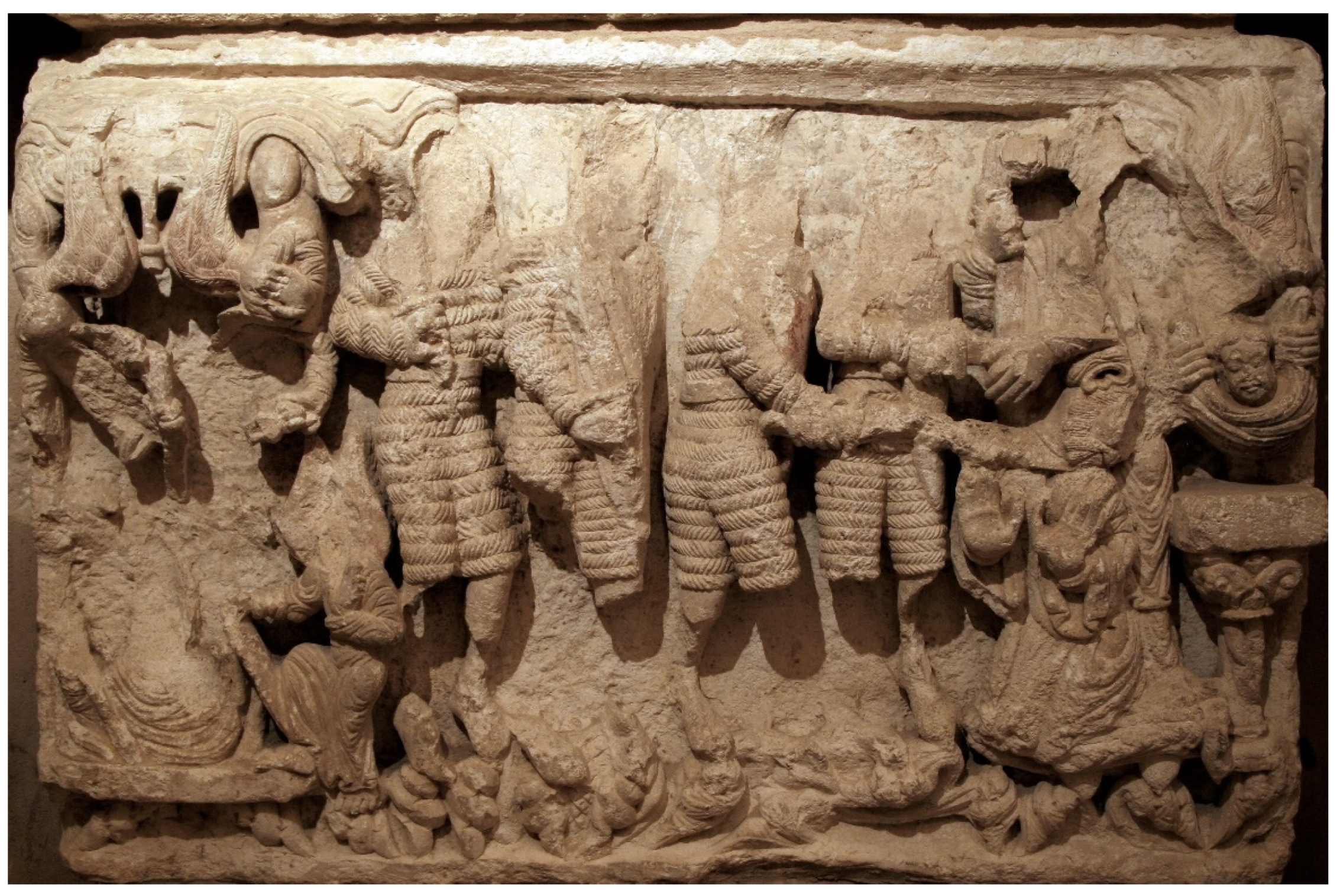
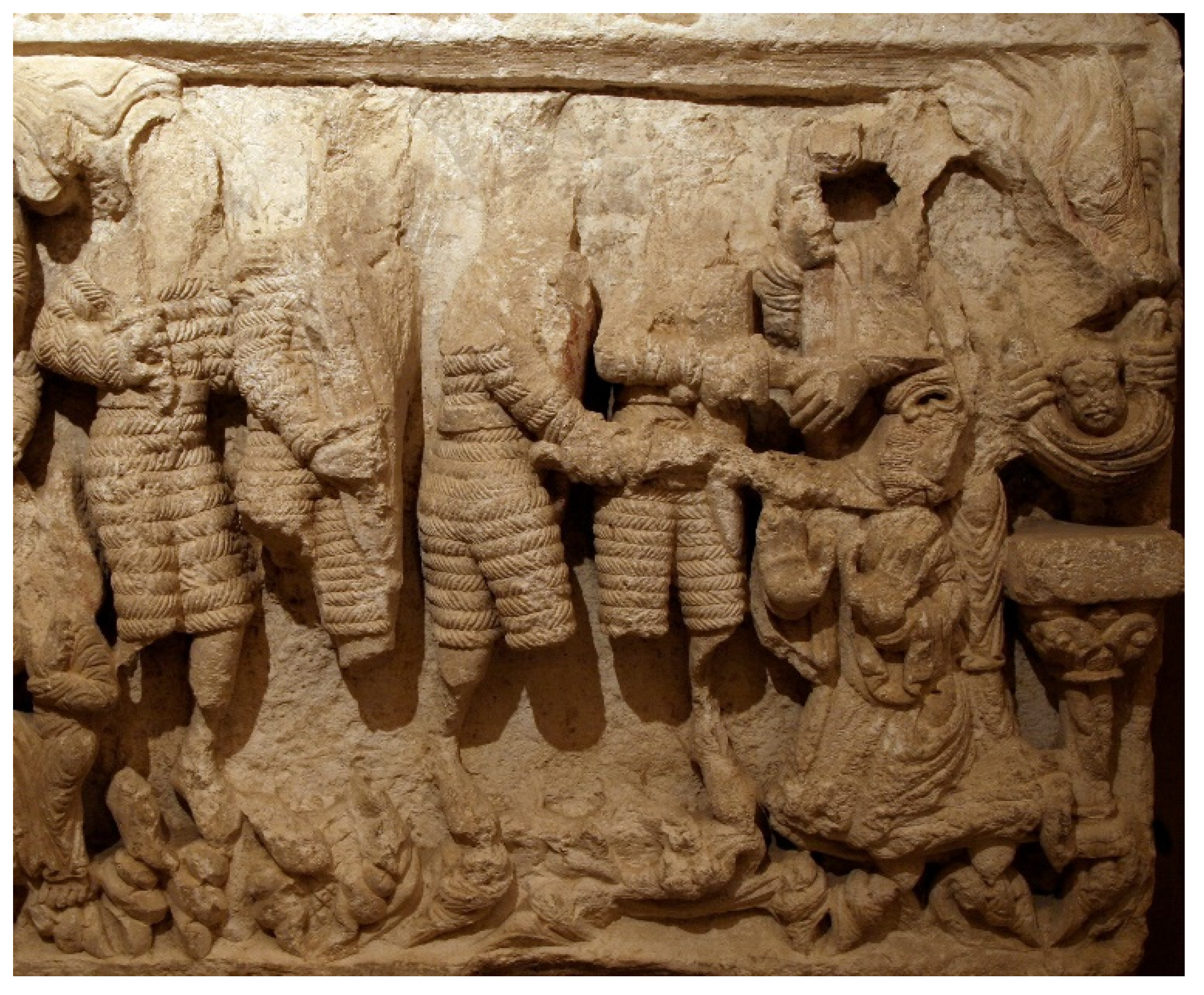
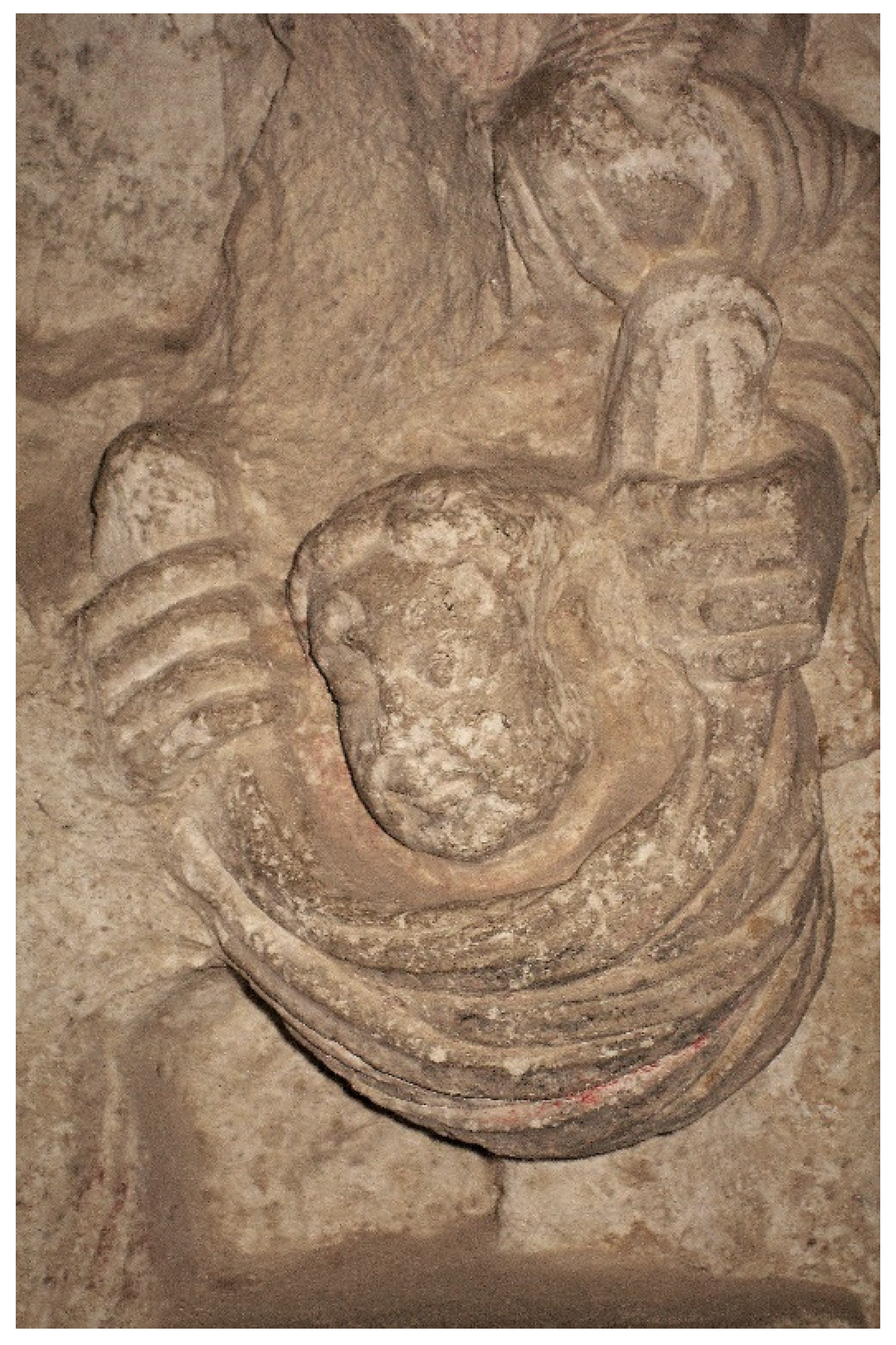
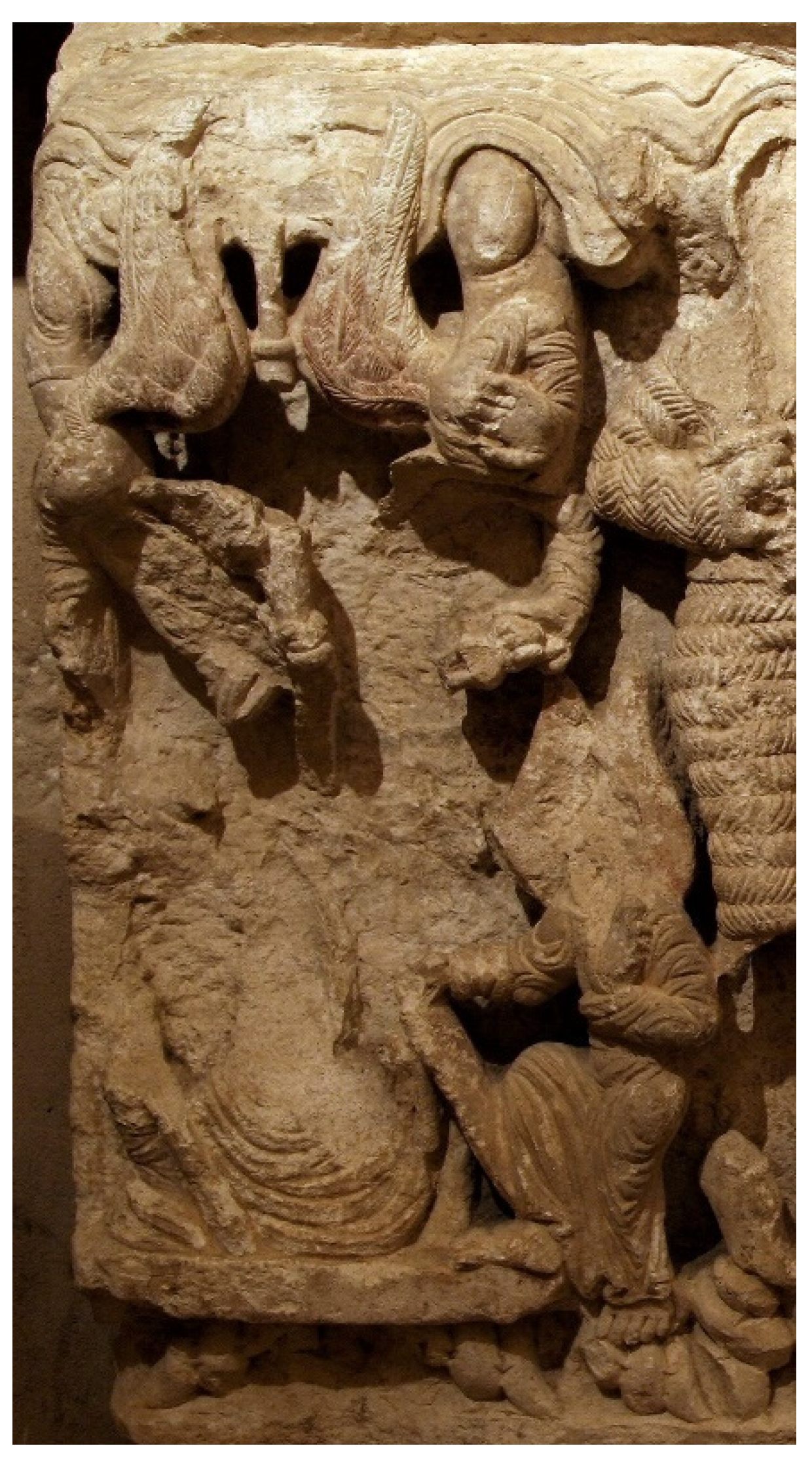
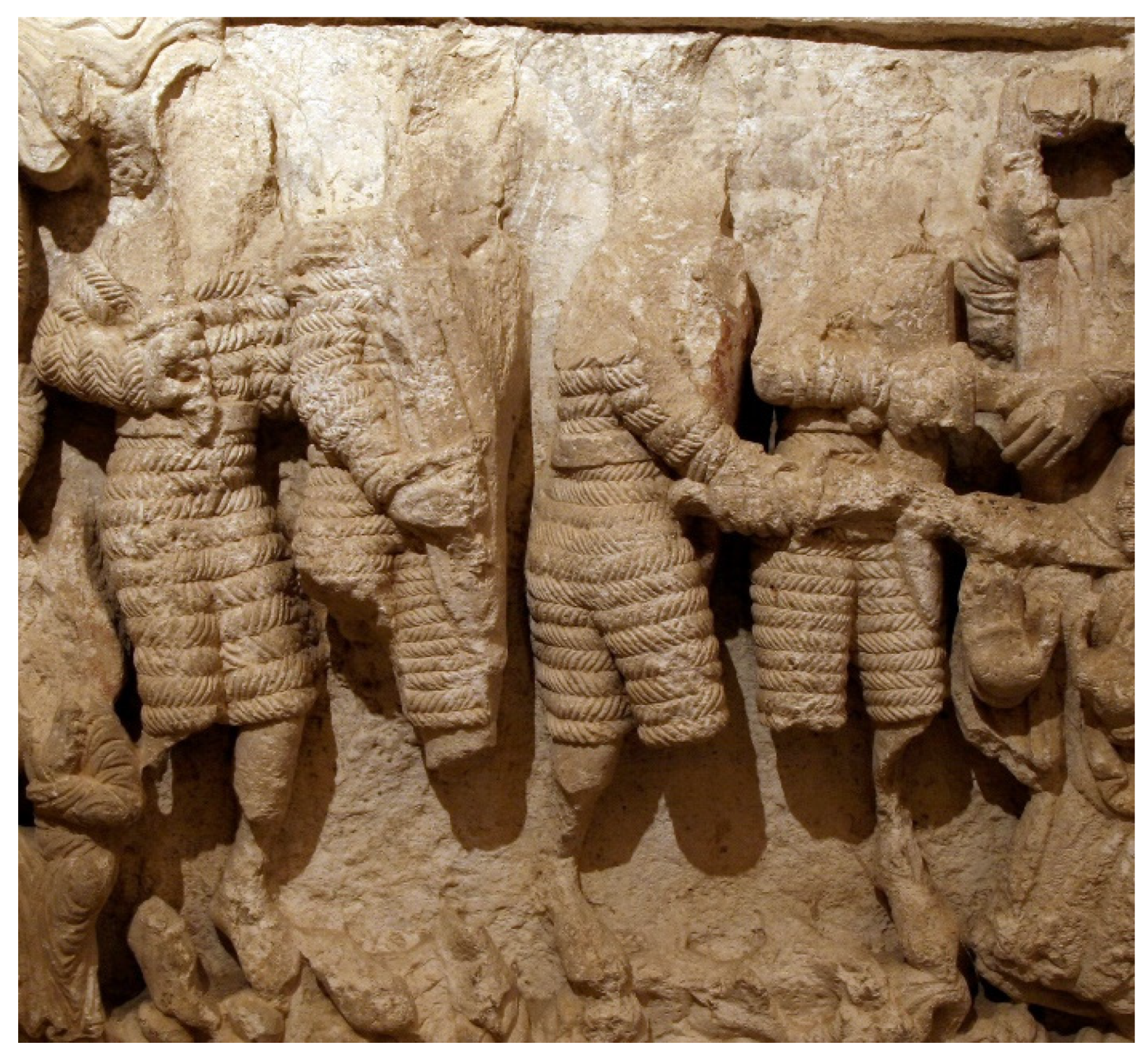

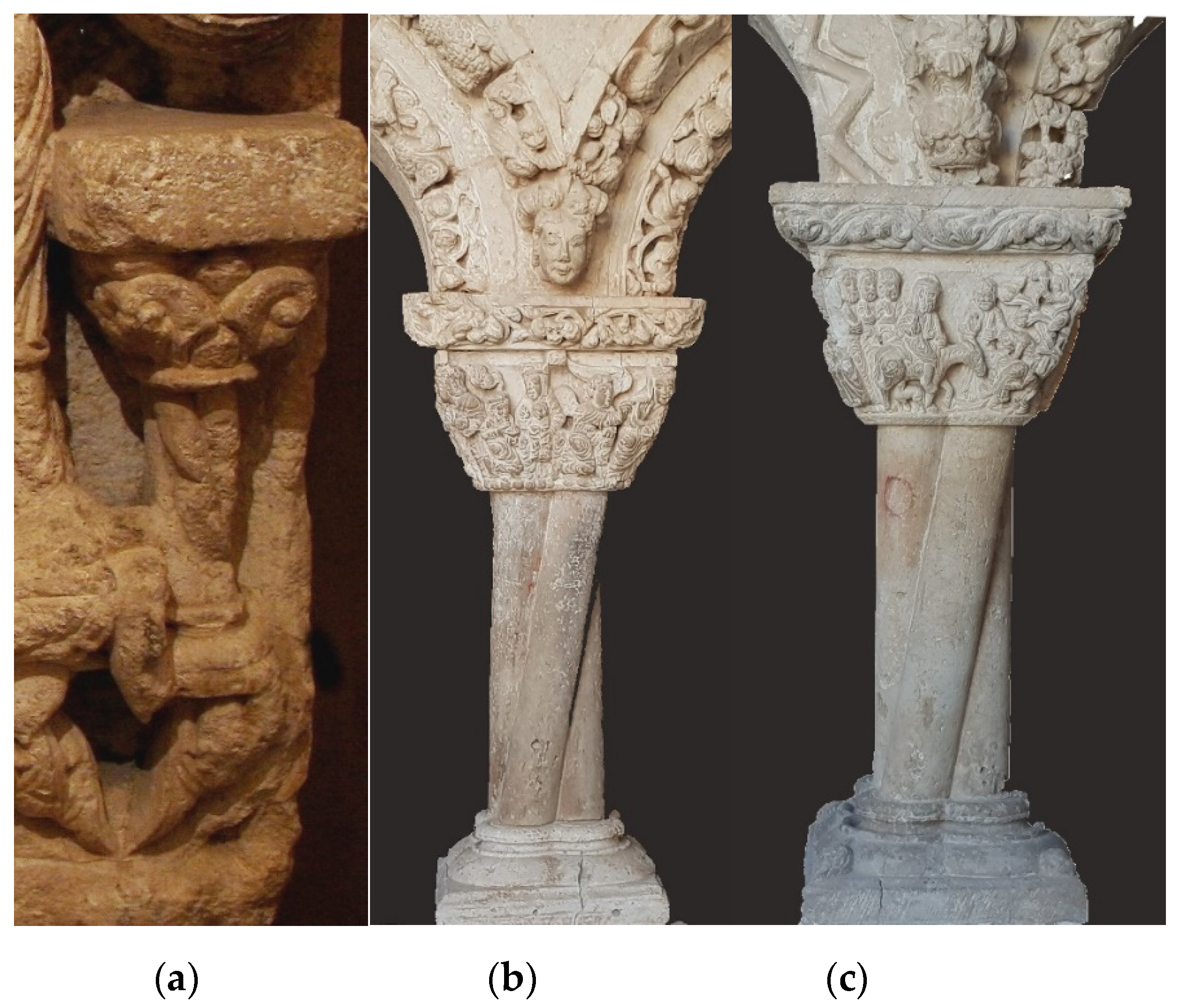
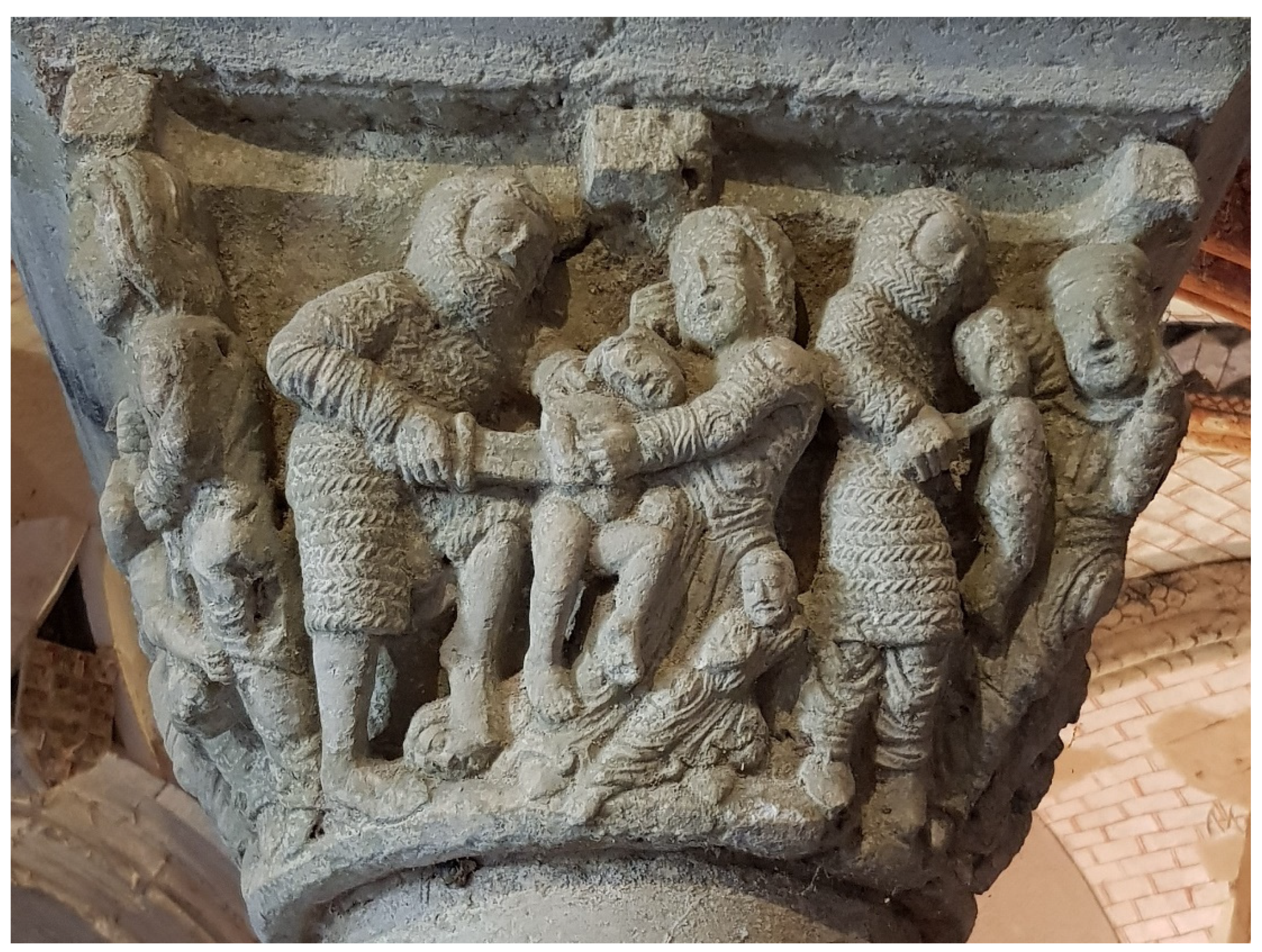
Publisher’s Note: MDPI stays neutral with regard to jurisdictional claims in published maps and institutional affiliations. |
© 2021 by the author. Licensee MDPI, Basel, Switzerland. This article is an open access article distributed under the terms and conditions of the Creative Commons Attribution (CC BY) license (https://creativecommons.org/licenses/by/4.0/).
Share and Cite
Poza Yagüe, M. From Canterbury to the Duero—An Early Example of Becket’s Martyrdom Iconography in the Kingdom of Castile. Arts 2021, 10, 72. https://doi.org/10.3390/arts10040072
Poza Yagüe M. From Canterbury to the Duero—An Early Example of Becket’s Martyrdom Iconography in the Kingdom of Castile. Arts. 2021; 10(4):72. https://doi.org/10.3390/arts10040072
Chicago/Turabian StylePoza Yagüe, Marta. 2021. "From Canterbury to the Duero—An Early Example of Becket’s Martyrdom Iconography in the Kingdom of Castile" Arts 10, no. 4: 72. https://doi.org/10.3390/arts10040072
APA StylePoza Yagüe, M. (2021). From Canterbury to the Duero—An Early Example of Becket’s Martyrdom Iconography in the Kingdom of Castile. Arts, 10(4), 72. https://doi.org/10.3390/arts10040072





